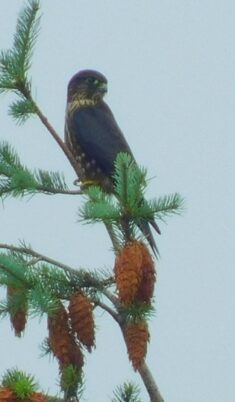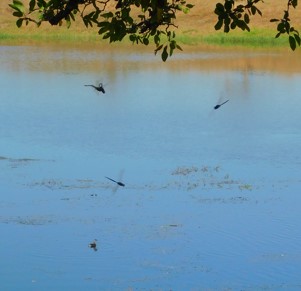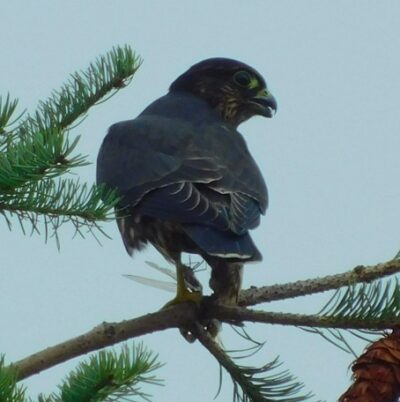The Ladyhawks of CPTC
The Ladyhawks of Clover Park

by Marcia Wilson
During the 2024 Grebe Survey conducted by the City of Tacoma, the Washington State Conservation Corps, and Clover Park Technical College, volunteers spied a mated pair of merlins flying over the lowlands.
Merlins are often difficult to see and photograph. They are small falcons, swift, and singularly focused on hunting. Look at the photos taken in the Douglas fir and compare the birds’ size with the fir cones; they are not easy to see, even when they are still. They are fast enough that when they are in flight, they are hard to track long enough to positively identify. Luckily for the recorders, the merlins were hunting a favorite autumn prey: Green Darner dragonflies, Washington State’s official insect!
Ladyhawks vs. mosquito hawks
Merlins are the original “Ladyhawk,” trained to hunt birds for female nobles. In medieval times, the class system was so regimented that falconry rights were plotted according to gender and rank. For unknown reasons, merlins were “suitable” for female nobles who used them for hunting larks.
Merlins are one of the many raptors that enjoy an insect dinner. Dragonflies are full of valuable fat and protein, and with the onset of fall, all birds are gobbling up whatever calories they can find.
But, dragonflies are notoriously difficult to catch. Few insects can match the speed of an alert dragonfly—up to 34 miles per hour is the top recorded speed—and they are highly maneuverable. As a frustrated volunteer for the collection survey once said, “They can’t smell, have no sense of hearing we know of, but they see you coming and fly just three inches out of reach of the collection net!”

Dragonflies are an avid predator of the countless mosquitoes that live in the marsh. They hunt them with a single-minded skill that led to their older common name of “mosquito hawk.”
Dine and dash
Merlins not only match the speed of dragonflies; they exceed. They achieve short, concentrated bursts of up to 50 miles per hour, and their short wings make them extra- maneuverable. Thus, a few hours hunting dragonflies over the quiet waters of Flett Creek will yield a lot of food that, while small, does not have to be de-boned and de-feathered. Dragonflies are literally and figuratively “fast food.” They may be small prey, but dragonflies are easier to catch and eat. This is a constant problem in the wild: will the chase consume more calories than the fruits of the hunt? The merlin’s success in hunting is a lowly 1 out of 20, and they have adapted their behaviors to survive. They will follow larger raptors, or stay close to where birds are easily frightened, hoping something will flush out a good meal. When they grab more than they can eat, they will cache the extra food for later.
The merlins were seen hunting for several hours and ignored the large number of small birds they normally hunt: bushtits, finches, sparrows and wrens. At the same time, the volunteers noticed most of the birds were hiding in the understories and scrubs but the mosquitoes were constantly out in the open, hovering over the water and the open grasslands.

Science is strange
Part of the reason why scientists know so much about the nutritional value of dragonflies is, they have been considered as a food source for humans. There are some unquestionably interesting arguments and research poured into the topic.
Merlin was not a merlin
The Merlin of Arthurian mythology has nothing in common with merlin the bird. It’s just one of those sometimes-bizarre linguistic coincidences with language. The avian merlin comes from the Old French esmerillon which means, “falcon,” while Merlin the Wizard comes from an older Cymric name, Myrddin the Wild. “Myrddin” was whitewashed into Merlin because some prudish scholars didn’t want his name confused with a rude French word for excretion.
Hawking a definition
“Hawk” comes from the old word *kap, which means “to grasp” and it is still found in that term in the Russian kobec, a word for falcon. The Scientific nomenclature for the Merlin breaks down as Falco columbarius. This translates to “Falcon+dove. Doves and pigeons are the largest prey the merlin can bring down, hence it is often called a Pigeon Hawk.
Should you spot a these voracious avian predators on the Flett, pause to appreciate a rare moment. Birds of prey have short lifespans, and the merlin’s is shorter than most. They are native to the South Puget Sound, yet not common to Pierce County. Think of them as quiet neighbors who prefer to know everyone’s business without showing their own.